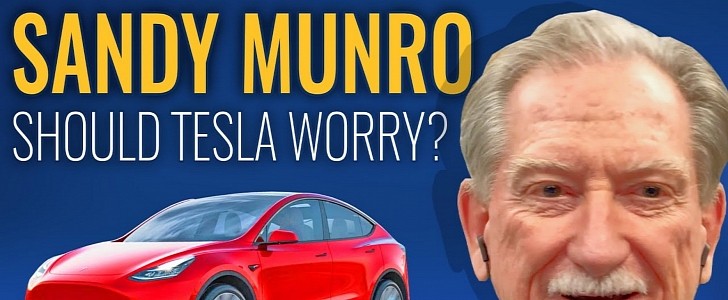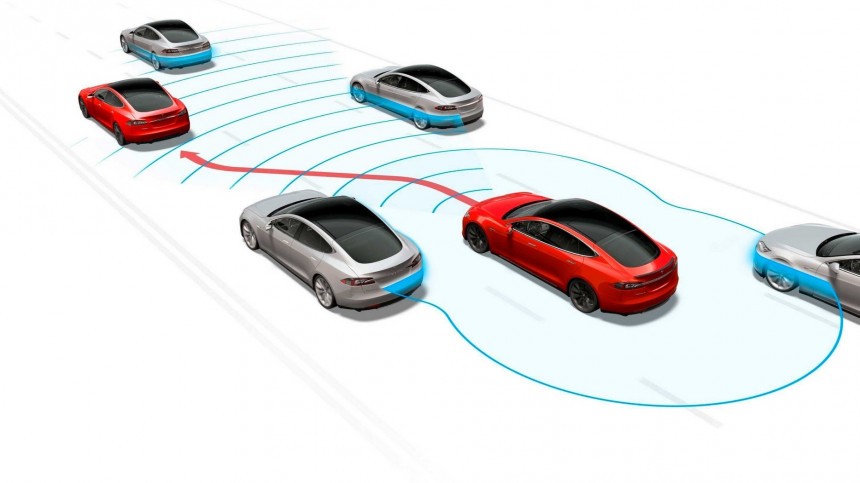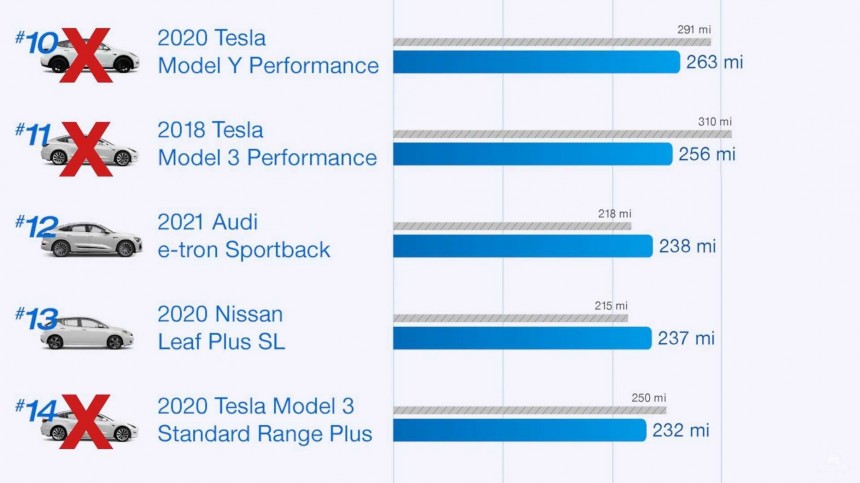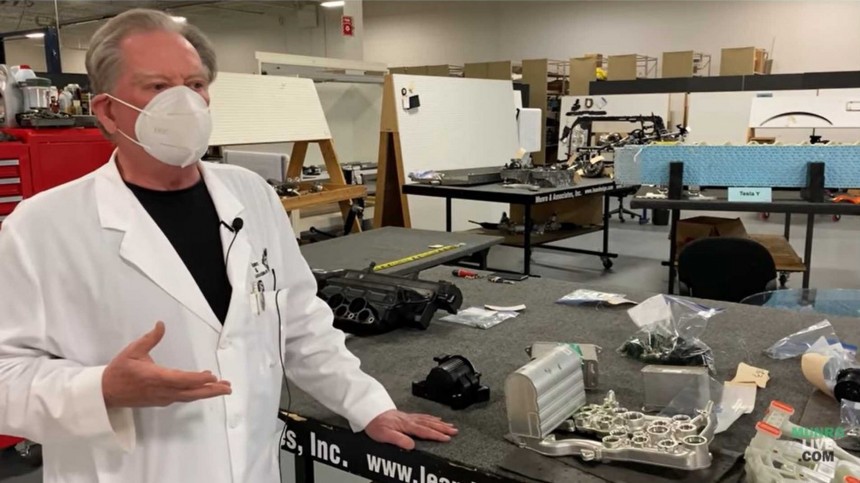Sandy Munro’s start with Tesla was a bumpy one. He reported things on the Tesla Model 3 teardown that were bad, such as build quality, paint, and manufacturing issues. At the same time, he was fascinated with the innovations the company introduced.
After he drove and tore down the VW ID.4 and the Ford Mustang Mach-E, Alex Guberman – from the E For Electric YouTube channel – asked him if he changed his mind about Tesla’s lead among EVs. The answer was no.
According to Munro, Tesla is still five to eight years ahead of the competition when it comes to technology. For him, the ID.4 is the vehicle that is in the last place, possibly because he expected Volkswagen to make a true revolution. Driving it and putting it apart made Munro change his mind and declare the ID.4 is a fine taxi. Guberman is the proud owner of one.
The YouTuber then asked Munro what sets Tesla so far ahead of the competition and why that happens. The engineer said he could not answer why: only the ones lagging behind could come up with an explanation. Regarding Tesla's upper hands, Munro named software something in which Tesla definitely leads with a significant head start.
At least two of the advantages that Munro brings up are concerning. Not to the competitors, but actually about what he considers to be a leg up. The first is that the engineer thinks that Tesla has got “ADAS systems” (Autopilot and FSD) that “are at Level 4, at least.”
That would make Tesla vehicles autonomous, and that is not true. No production vehicle or prototype is fully autonomous. Tesla itself told regulators both of its systems are Level 2, so it is dangerous for anyone to believe there’s anything at Level 4 of autonomous driving at this point.
The second edge Munro brings up is energy efficiency. He said a Tesla has a 75 kWh battery pack and achieves 125 MPGe, according to EPA (Environment Protection Agency). He’s probably referring to the Model Y Long Range, which has precisely these numbers.
The Ford Mustang Mach-E has an 88-kWh battery pack and would deliver 101 MPGe, but the EPA website informs 100 MPGe for that EV. The agency also says that the Hyundai Ioniq EV delivers 133 MPGe, which is higher than the Tesla Munro used as an example.
The engineer then mentions that the ID.4 has an 82-kWh battery pack and achieves 97 MPGe, but there’s a derivative that gets 99 MPGe. The issue is that Volkswagen has stressed more than once that the 82 kWh are not all usable: only 77 kWh are. The MEB battery pack has a buffer. To make matters worse, there’s a catch with the EPA numbers.
Car and Driver already mentioned Tesla achieves its ratings using a more complex procedure to disclose better figures. Edmunds put EVs to the test and verified only two Teslas meet their EPA ranges. All competitors exceed their official numbers, which shows that EPA is failing to present a trustworthy comparison basis.
When Munro gets to manufacturing, his vision for Tesla's strong points did not cause any discomfort. According to him, the ID.4 has twice as many electronic modules as in a Model Y. That probably has to do with core computing, something Volvo promises the future XC90 will have.
Guberman then asked Munro what legacy automakers need to do to catch up with Tesla. He seized the opportunity to reinforce that what Munro & Associates do could help them a lot. If he could tear the ID.4 down for Volkswagen and send the company his suggestions to improve the electric crossover, he is sure that it would be a lot lighter, less prone to problems, and much more efficient than today’s machine.
Among those suggestions, Munro would tell them to embrace verticalization and avoid off-the-shelf components. Developing something that replaces multiple parts – like the Octovalve and the Super Manifold did for Tesla cars – would be the right way to go. The more components you have, the higher the chance that one of them will fail.
For Munro, the deal is to stop the lazy approach of just adding stuff suppliers sell. EVs need weight-saving as much as possible to travel further, be more reliable and energy-efficient. We couldn’t agree more.
According to Munro, Tesla is still five to eight years ahead of the competition when it comes to technology. For him, the ID.4 is the vehicle that is in the last place, possibly because he expected Volkswagen to make a true revolution. Driving it and putting it apart made Munro change his mind and declare the ID.4 is a fine taxi. Guberman is the proud owner of one.
The YouTuber then asked Munro what sets Tesla so far ahead of the competition and why that happens. The engineer said he could not answer why: only the ones lagging behind could come up with an explanation. Regarding Tesla's upper hands, Munro named software something in which Tesla definitely leads with a significant head start.
At least two of the advantages that Munro brings up are concerning. Not to the competitors, but actually about what he considers to be a leg up. The first is that the engineer thinks that Tesla has got “ADAS systems” (Autopilot and FSD) that “are at Level 4, at least.”
The second edge Munro brings up is energy efficiency. He said a Tesla has a 75 kWh battery pack and achieves 125 MPGe, according to EPA (Environment Protection Agency). He’s probably referring to the Model Y Long Range, which has precisely these numbers.
The Ford Mustang Mach-E has an 88-kWh battery pack and would deliver 101 MPGe, but the EPA website informs 100 MPGe for that EV. The agency also says that the Hyundai Ioniq EV delivers 133 MPGe, which is higher than the Tesla Munro used as an example.
The engineer then mentions that the ID.4 has an 82-kWh battery pack and achieves 97 MPGe, but there’s a derivative that gets 99 MPGe. The issue is that Volkswagen has stressed more than once that the 82 kWh are not all usable: only 77 kWh are. The MEB battery pack has a buffer. To make matters worse, there’s a catch with the EPA numbers.
When Munro gets to manufacturing, his vision for Tesla's strong points did not cause any discomfort. According to him, the ID.4 has twice as many electronic modules as in a Model Y. That probably has to do with core computing, something Volvo promises the future XC90 will have.
Guberman then asked Munro what legacy automakers need to do to catch up with Tesla. He seized the opportunity to reinforce that what Munro & Associates do could help them a lot. If he could tear the ID.4 down for Volkswagen and send the company his suggestions to improve the electric crossover, he is sure that it would be a lot lighter, less prone to problems, and much more efficient than today’s machine.
For Munro, the deal is to stop the lazy approach of just adding stuff suppliers sell. EVs need weight-saving as much as possible to travel further, be more reliable and energy-efficient. We couldn’t agree more.










